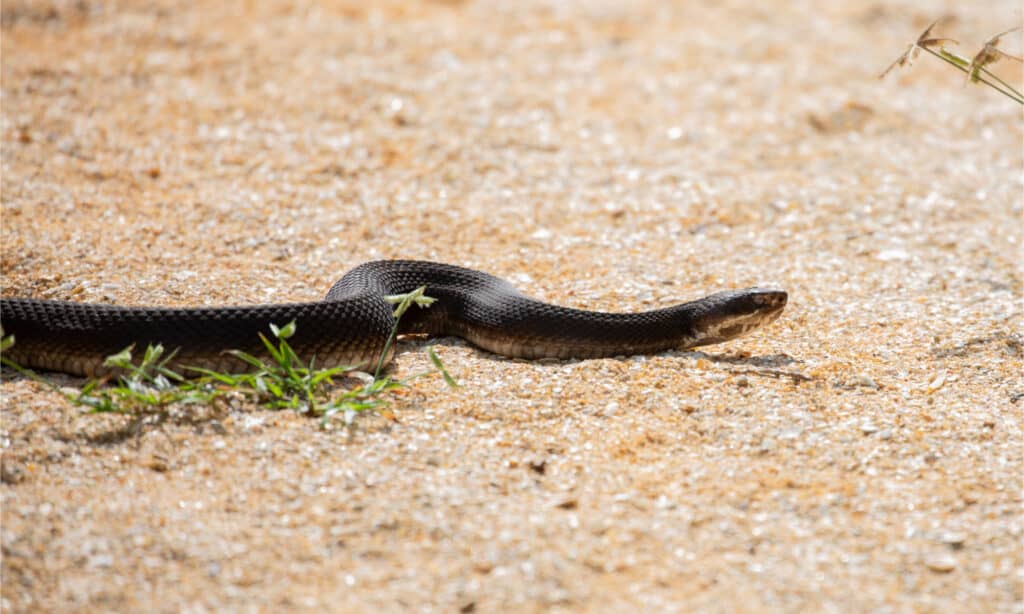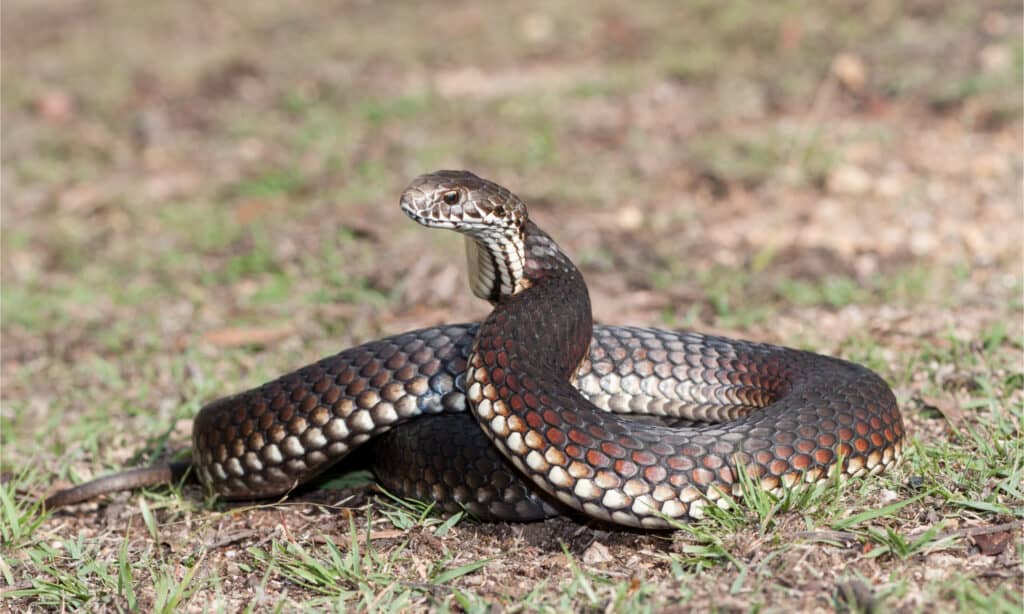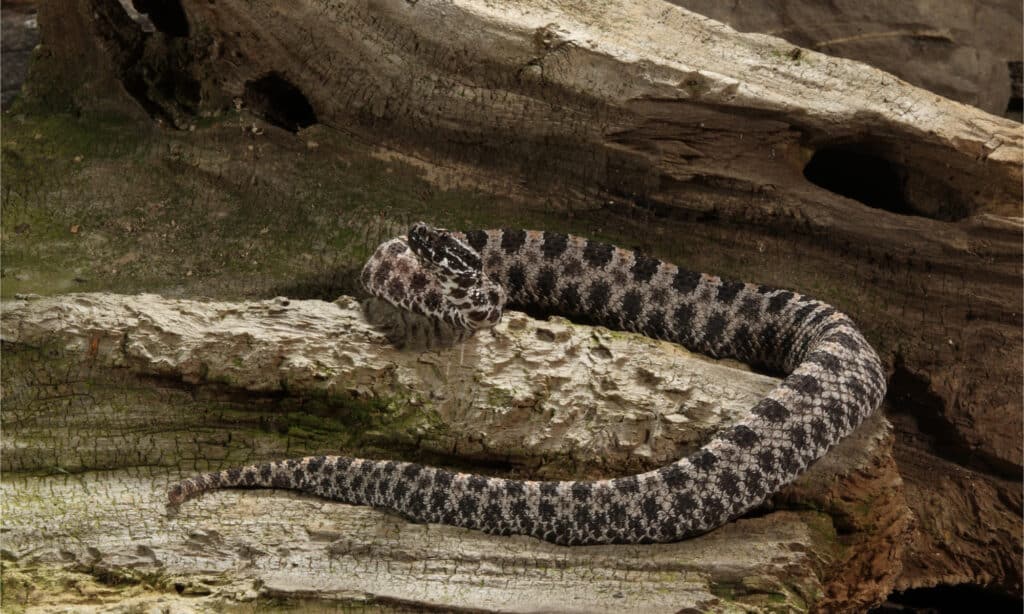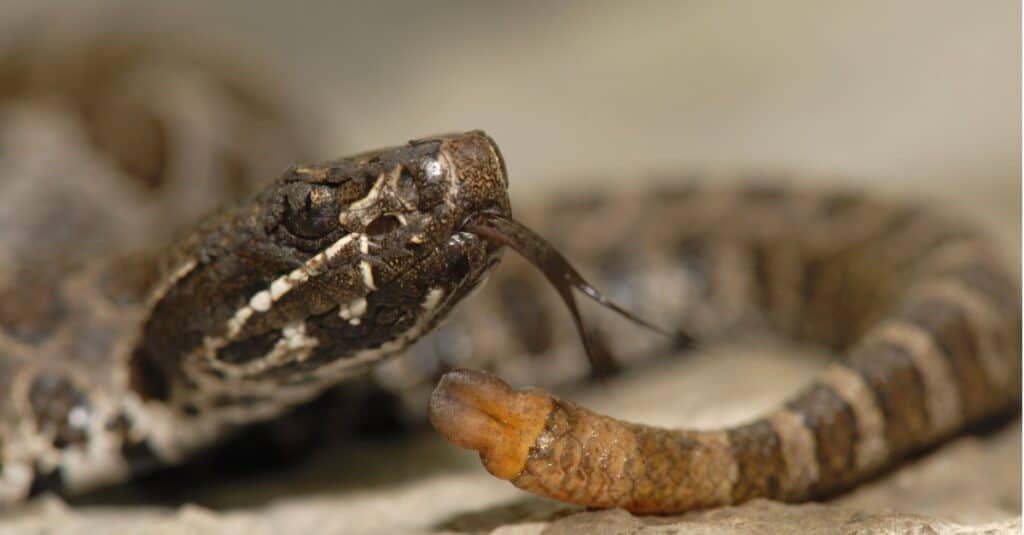Missouri is a stunning state in the midwestern region of the United States. It is best known for the Missouri River after which it is named and the vast and beautiful Ozarks in the south of the state. However, Missouri is also known for its wildlife and there are 38 snakes which make their home in the state – including five that are venomous. One of these venomous snakes is the cottonmouth (also known as the water moccasin). So, let’s discover everything you need to know about cottonmouths in Missouri!
What do Cottonmouths in Missouri Look Like and How Do They Behave?
Cottonmouths were originally classified as one single species with three subspecies – eastern, western, and Florida cottonmouths. However, after much research it was decided that there were no significant differences between the eastern and western subspecies and these two were amalgamated into one single species which is now called the northern cottonmouth (Agkistrondon piscivorus). However, there were enough differences found between these and the Florida subspecies to reclassify that as its own separate species – the Florida cottonmouth (Agkistrodon conati).
Although the eastern and western subspecies are no more, the cottonmouths in Missouri are what were formerly the western subspecies. Cottonmouths in Missouri are large snakes that reach between 30 and 42 inches long. They have a thick body with a large head, a blunt snout, and keeled dorsal scales. As they are pit vipers, they have two heat-sensing pits between their eyes and nostrils. Cottonmouths are dark colored – dark brown to black – and have darker crossbands across their body. However, sometimes they are so dark that it is virtually impossible to see their crossbands.
Juvenile cottonmouths don’t look quite the same as adults though, as they are light or tan, brown with reddish-colored crossbands. They also have a bright yellow tail tip.
However, the most distinctive feature of a cottonmouth – and one that we really don’t want to be close enough to see – is the white lining of their mouth. This resembles cotton, hence the name “cottonmouth,” and can usually be seen when they adopt a defensive position. This defensive position involves coiling their body while opening their mouth wide.

Cottonmouths have a thick body with a large head, a blunt snout, and dark scales.
©iStock.com/Saddako
Where do Cottonmouths in Missouri Live?
Cottonmouths are excellent swimmers and are almost always found in and around water in Missouri. However, they don’t live across the entire state. Cottonmouths mainly occur in the southeastern region of the state and none of them are found north of the Missouri River.
However, even within the southeast of the state, cottonmouths occur in two different population groups and habitats. There is a scattered population of cottonmouths in the southern Ozarks where they live in river sloughs and rocky creeks, whereas in the rest of the southeastern region, cottonmouths prefer to live in swamps and oxbow lakes.
Cottonmouths prey on animals both in and out of the water and eat a wide range of small mammals, birds, fish, amphibians, lizards, and other snakes. They are primarily nocturnal and are most active between April and early October. As the weather becomes colder they move to bluffs to find a suitable place to overwinter – usually in crevices on ledges.

Cottonmouths are excellent swimmers and are almost always found in and around water in Missouri.
©jo Crebbin/Shutterstock.com
How Dangerous are Cottonmouths in Missouri?
Snakes have a bad reputation for being dangerous and people fear venomous snakes the most. There are between 7,000 and 8,000 bites in the US every year from venomous snakes, which result in approximately five deaths. Cottonmouths are responsible for approximately 1% of these snake bites across the entire US. However, across their known range this rises to 7.3%.
Missouri has five other venomous snakes and cottonmouths inflict 4 to 5% of bites in the state. However, they are not responsible for many deaths. Although there are no reliable historical records, the death of a man in 2015 was believed to be the first ever fatality from a cottonmouth in the state. The 37 year old man was bitten on both legs while wading in James River in Christian County. He died the same night.
Cottonmouth Venom
Although cottonmouths are not responsible for many deaths, don’t be fooled into thinking that they are not dangerous. Most venomous snakes contain either neurotoxic, cytotoxic, hemotoxic, or proteolytic venom which all work in different ways. Cottonmouths contain cytotoxic venom, which works by destroying tissue. Even though cottonmouth bites are rarely fatal, their venom can still cause extensive scarring. This is because as it destroys the tissue it makes the skin blister by causing either apoptosis (cell death) or necrosis (tissue death). In some cases, amputation of the affected limb may be required.
As well as having powerful venom, cottonmouths also have a high venom yield. On average, each cottonmouth bite can produce 125mg of potent venom, although in some cases this can be as high as 237mg. For reference, the lethal dose for a human is estimated to be between 100 and 150mg.
What Should You Do if You See Cottonmouths in Missouri?
Most bites from venomous snakes, including cottonmouths, are caused by people accidentally standing on them. However, in the case of cottonmouths this can happen in the water too.
If you do find a cottonmouth, then you should never attempt to approach it or pick it up. If you are too close to it, then you should immediately (but calmly) move away from it. Do not run as this is likely to provoke the snake.
Cottonmouths typically see the water as their place of safety and that is where they are likely to want to head when they are disturbed. So, if you are between a cottonmouth and water, then you should move aside.

If you do find a cottonmouth, then you should never attempt to approach it or pick it up.
©Linda Burek/Shutterstock.com
What Should You Do if You are Bitten by a Cottonmouth?
If you are unfortunate enough to be bitten by a cottonmouth, then the main symptoms that you will experience are swelling in the affected area and intense pain. The most important thing that you should do if you are bitten is to get medical treatment immediately. Although the bite might not seem that serious at first, the venom acts quickly and the situation can become much worse in a matter of hours. Bites can be treated with antivenom, but for the best results this should be administered as soon as possible.
Never attempt to remove the venom on your own and do not use a tourniquet or put ice on the wound, as these can actually make things worse.
Other Venomous Snakes in Missouri
There are four other venomous snakes in Missouri and their range varies across the state, as does the threat level they pose.
Copperhead
These snakes are 20 to 37 inches long and are a distinctive pinkish tan color with darker brown crossbands. Copperheads are found across the entire state with the exception of the counties bordering Iowa. They live in a variety of habitats, including grasslands, woodlands, and rocky hillsides. Although they are related to cottonmouths, they typically have weaker venom.

Copperheads live in a variety of habitats, including grasslands, woodlands, and rocky hillsides.
©Ken Griffiths/Shutterstock.com
Pygmy Rattlesnake
The smallest of Missouri’s venomous snakes is the pygmy rattlesnake which is only 16 to 24 inches long. They are tan or grey with black blotches and a red stripe. Pygmy rattlesnakes only live in the southern region of the state, typically near the Arkansas border, in the eastern Ozarks, and the St. Francois mountains. They prefer areas with rocky and wooded hillsides. As they are so small, they don’t contain a lot of venom, so they are rarely dangerous to healthy adults.

The smallest of Missouri’s venomous snakes is the pygmy rattlesnake which is only 16 to 24 inches long.
©Dennis W Donohue/Shutterstock.com
Massasauga Rattlesnake
An endangered venomous snake is the massasauga which is only found in scattered locations in the north-west and north-central regions of the state. Massasaugas live in marshes and prairies in and around floodplains, but they overwinter in crayfish burrows. They are typically 18 to 30 inches long and are grey or tan with black or brown blotches.

A massasauga rattlesnake is grey or tan with black or brown blotches.
©iStock.com/Shoemcfly
Timber Rattlesnake
The largest venomous snake in Missouri is the timber rattlesnake, which is 36 to 60 inches long. These snakes are dark brown with darker brown to black crossbands. They live statewide, although they are absent from some counties, and occur in forests and on rocky hillsides.

Timber rattlesnakes are dark brown with darker brown to black crossbands.
©Scott Delony/Shutterstock.com
Up Next
- Discover the 3 Types of Rattlesnakes in Missouri
- Discover the 10 Largest Animals in Missouri, and Where You’ll Find Them
- 38 Snakes in Missouri (5 are Venomous)
The photo featured at the top of this post is © Psychotic Nature/Shutterstock.com
Discover the "Monster" Snake 5X Bigger than an Anaconda
Every day A-Z Animals sends out some of the most incredible facts in the world from our free newsletter. Want to discover the 10 most beautiful snakes in the world, a "snake island" where you're never more than 3 feet from danger, or a "monster" snake 5X larger than an anaconda? Then sign up right now and you'll start receiving our daily newsletter absolutely free.
Sources
- National Library of Medicine, Available here: https://www.ncbi.nlm.nih.gov/books/NBK546645/
- Centers for Disease Control and Prevention, Available here: https://www.cdc.gov/niosh/topics/snakes/default.html#:~:text=Each%20year%2C%20an%20estimated%207%2C000,than%20to%20die%20from%20them
- Live Science, Available here: https://www.livescience.com/43597-facts-about-water-moccasin-cottonmouth-snakes.html#:~:text=%22Like%20all%20pit%20vipers%2C%20%5B,which%20is%20often%20potential%20prey.
- News Leader, Available here: https://eu.news-leader.com/story/news/local/ozarks/2015/05/29/recent-death-cottonmouth-might-first-ever-missouri-expert-says/28167497/
- Missouri Field Guide, Available here: https://mdc.mo.gov/discover-nature/field-guide/northern-cottonmouth#
- Missouri State Gov, Available here: https://education.mdc.mo.gov/discover-nature/field-guide/northern-cottonmouth
Thank you for reading! Have some feedback for us? Contact the AZ Animals editorial team.







